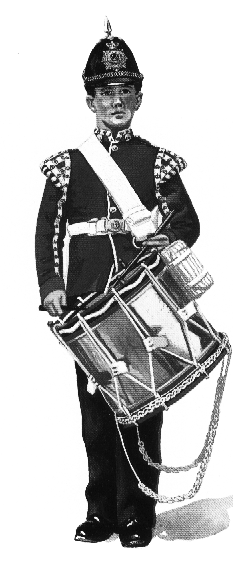
foreword | Historical Narratives | Resources | Links | Contact
THE KING'S DUTY LIES HEAVY ON ME
History speaks for itself.
Fifty I got for selling my coat,
Fifty for selling my blanket,
If ever I 'lists for a sodger again,
The Devil shall be me sergeant.
Poor old sodger, poor old sodger.
Twice tried for selling me coat,
Three times tried for desertion.
If ever I be a sodger again,
May the Devil promote me sergeant.
Poor old sodger, poor old sodger.
The words above were sung to The Rogue's March, a tune played when a soldier was drummed out of the regiment.
Discipline is at the heart of the military. It and the punishment that flows therefrom have mellowed over the years. What now is temperate and tolerable was once brutally barbaric for poor 'Tommy Atkins,' the pseudonym assigned to the universal British soldier garrisoned in Upper Canada.
The rules and regulations that determined discipline were found in the Mutiny Act and the Articles of War. Both were published annually, so they would reflect changing military law and the altered attitude of the public and parliamentarians to military crime and punishment.
In addition to desertion, crimes once punishable by death included mutiny and failure to give notice of mutiny. Striking an officer or disobedience to a superior carried a possible death penalty, as did crimes committed during the presence of the enemy, such as surrendering a post without offering resistance, or aiding or abetting the enemy. Being asleep on duty or quitting one's post might also result in execution, although the ultimate penalty for these lapses was more likely to be applied only during time of war.
Occasionally for some of these crimes, soldiers were dispatched to another location instead of to another world. Such punishment was known as 'transportation' and resulted in men being shipped in chains to distant destinations like the West Indies or Australia where they were usually worked to death in convict gangs.
While banishment to Bermuda would certainly not be considered cruel or unusual punishment today, it once meant almost certain death, for yellow fever was rampant on the islands. Left to languish for years in the disease-ridden West Indies, soldiers were literally decimated by sickness. A staggering 80,000 men died on various Caribbean islands between the years 1794 and 1796. One regiment alone lost 1500 men.
Before being transported, the victims suffered a painful and permanent indignity. They were brought before their peers and tattooed on the forehead with the letter `D' for deserter or `BC' for bad character traced onto the skin. This was then punctured with the saddler's needles, following which gunpowder was rubbed into the bleeding wound.Prior to 1800 a soldier sentenced to be executed was hanged and afterwards "his body hung in chains to deter others." In 1678 a soldier of the Coldstream Guards was tried for desertion, convicted and sentenced to be hanged at the head of his regiment. During the 19th century soldiers sentenced to death were shot and the execution procedures attending that judgment were always precise and punctual.
The procession was drawn up in designated order and marched off at a specified time, usually early in the morning, to the site of the execution. All the while the band and drummers droned the Death March dirge, the drums muffled with black cloth. Next came the firing party with arms reversed, then came the coffin borne by four men, always followed by its intended occupant in company with the minister praying. The man to be executed was always flanked by a man on either side with swords drawn. As the victim passed his own regiment, he nodded his head in salute.
When the party arrived at the location of the execution, the troops were drawn up in a semi-circle. formed three sides, the opening left for the shot to pass through when the soldiers discharged their muskets. The coffin and the condemned soldier, his hands pinioned behind him, moved into this open side. The sentence and warrant of execution were read, then while the prisoner knelt on his coffin, the chaplain said the prayer for malefactors and general thanksgiving.
The firing party advanced to within eight yards of the prisoner, made ready, aimed, and on command, fired. An observer at two executions in 1812 commented: "This example had the desired effect." And so it served its intended end. "The prime purpose of punishment," said the Duke of Wellington "is to deter others and not merely to improve the conduct of the erring individual." A Royal Commission on Military Punishment asserted that any punishment inflicting severe pain "must consist of its efficacy as an example, the reformation of the person undergoing it being secondary."
If the number of offenders was inconveniently large, an example was sometimes made by selecting every tenth man by lot to suffer, or as occurred on September 8th, 1663, when "two privates threw dice on a drum-head, the one to be shot throwing the lowest number."Some crimes earned the criminal double punishments. Self-mutilation to avoid duty or to achieve discharge resulted in the malingerer suffering a flogging and a financial penalty, such as, loss of pay or part of a pension. Confinement in the black hole on bread and water was another punishment, although it was not always popular with some officers, who claimed that it "soured a man's disposition." Lesser offences like blasphemy resulted in a hole in the tongue, burned and bored therein using a red-hot iron.
The most frequently committed crime was drunkenness. Called the solace of a soldier's life and the bane of his existence, alcohol was the "main parent of all crime in the army." Recruiting parties set up shop in taverns where luckless lads were besotted with ale until they passed out. When they "came around they discovered the King's shilling in their pockets," which indicated they had enlisted. The State offered every inducement for 'Tommy' to drink, then it deplored the drunkenness that resulted.
While treated leniently and tolerated as preferable to desertion, drunkenness was dealt with harshly if it became habitual, or if it occurred while one was on duty under arms. For this evil, flogging was normally prescribed. Introduced into the British army by William III, flogging became in the opinion of many, including the privates who received it, absolutely essential to control in Wellington's words, "the scum of the earth."
 |
|
William III |
Wellington saw discipline as a means to an end and argued that it had to be harsh and deterrent because of the type of recruits the army received. "Conscription," said Wellington, "calls out a share of every class, no matter whether your son or my son, all must march, but voluntary recruiting was bound to attract the very worst members of society." Often the behaviour of those who were flogged was little changed. Even the erection of gallows and triangles in the square failed to frighten some who persisted in flouting the rules and regulations.
 |
|
Duke of Wellington |
The 'Cat' was administered with scripted ceremony that was more elaborate even than that for the presentation of medals. Punishment parade was ordered for early morning and friends of the prisoner often tried to smuggle him liquor to dull the panic and the pain. On one occasion liquor was offered in the barrel of the guard's musket. The repulsive spectacle inspired fear and trembling in the onlookers, some of whom actually cried like babies at its sickening savagery. On more than one occasion the intended recipients chose death over degradation and the awful pain and committed suicide.
All ranks were assembled in a square facing inward toward the 'triangle,' which was constructed of three sergeants' halberds lashed together. The prisoner was marched into the square to the drummers' beat. The proceedings and the sentence having been read out, the prisoner was striped to the waist and tied spread-eagled to the triangle. A red cloth cap was placed on his head and a buff coloured collar placed around his neck in order to protect these sensitive parts from the lacerating lash.
There was no regulation cat-o'-nine-tails, but most conformed to the dimensions of one belonging to the Coldstream Guards. Its complete weight was 1.5 kg; the length of the handle was 48 cm, attached to which were nine 61-cm lengths oftarred hemp whipcord. To ensure maximum laceration the end of each lash was either plaited or knotted so that in the latter case from 3 to 9 weights were propelled against the flesh. The more knots, the greater the injury. It was charged that some officers steeped the lash in brine before as well as during its application in order to increase the pain.
The lash was administered by the drummer. The adjutant commanded: "Drummer, do your duty." and the drum major counted to three between each stroke while the drummer stripped to the waist in order to be able to apply the whip "with force and vigour," inflicted 25 of his best, after which he was spelled by another drummer. "Failure to 'lay it on' resulted in the drum major applying his cane to the drummer's back."
 |
|
Drummer |
It took between one-half to three quarters of an hour to inflict 175 lashes. They were given 25 at a time to the tap of a drum beaten in slow time. Blood ran freely after the first few strokes. Following 25 the back was reduced to jelly. Water was kept handy to revive the victim if perchance he should faint for every stroke had to be fully felt. The excruciating pain had to be endured in silence for the soldier's code demanded no outcry.
Sentences from one hundred to more than two thousand lashes were once common, in the latter instance the lashes were administered over several sessions. In this event the victim was hospitalized until his back healed and he was then returned to the triangle for the balance of his sentence. In 1712 a Guardsman was sentenced to 1700 lashes which were administered over seven sessions. His crime: slaughtering his Colonel's horse and selling its hide.
Extracts from the Regimental Defaulter Book of the 49th Regiment record the following crimes and punishments in 1811:
"A private deficient in part of uniform; sentenced to 100 lashes 'inflicted after the usual manner'"
"Attempt to deceive inspecting officer, sentenced to 200, 100 inflicted."
"In possession of peas which cannot be explained and improper use of equipment, sentenced 400, inflicted 250.
"Drunk before dinner although confined to barracks, sentenced 150 lashes but only 100 inflicted.
"Quitting barracks without leave after tattoo, sentenced 300, 295 inflicted."
Following punishment the prisoner was marched off to the hospital where his shredded back was dressed in a dilute solution of sugar of lead kept in place with a cloth called a wrestling jacket. The treatment, which lasted three weeks to a month, equalled the punishment in pain.
In 1807 George III was graciously pleased to restrict corporal punishment to 1000 lashes. His son, the Duke of York, Commander-in-chief of the army, advised commanding officers in a confidential circular in 1812 to limit lashes to 300.
 |
|
George III |
However, his brother, the Duke of Kent, Queen Victoria's father, fervently believed in the practice. He was constantly preoccupied with the unrelenting minutiae of barrack-yard drill and dress - the exact distance from button to button on the soldier's jacket, the width of his leather stock and various other inconsequential matters of this kind - always finding it preferable to reproach than to praise, this noble nit-picker continued to order barbaric floggings.
Repeat floggings to complete a long sentence were forbidden in 1837 and corporal punishment was abolished in the military in 1881.
 |
|
Duke of Kent |
Startling facts are found from an examination of punishment records.
(1) The first was that flogging was no deterrent. (2) The second is that some of the soldiers of the 18th century were incredibly tough. On the ship Victory, which became Nelson's flagship, between January and July, 1804 no fewer than 105 men were flogged, 13 of them more than once. One man was flogged four times: 10th January-12 times; 5th March-36 times; 5th April-48 times; 24th May-48 times.Copyright © 2013 Website Administrator